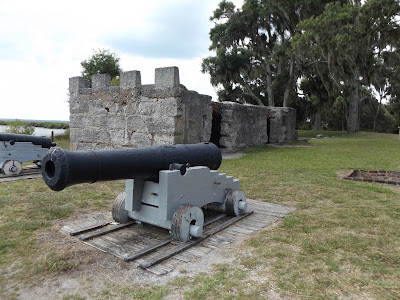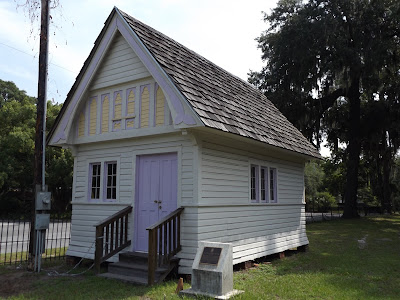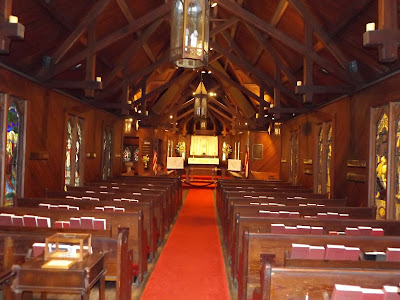July 18, 2015
Florida bound, we landed on the south Georgia coast for a week of decompression. As I navigated our way to the RV park, I instructed Chris to turn west per directions - I pointed the way, knowing it was correct because there was the ocean. Hmmm . . . amazing how ingrained in a westerner's mind it is that the ocean is to the west . . . even when said westerner is on the east coast. Luckily, Chris discerned that the Atlantic would be in the opposite direction, to our east.
Continuing my east/west confusion, it soon became obvious that I was woefully ignorant of the significance of Georgia's history in relation to the American colonies. After a week of sightseeing, I have scarcely scratched the surface of the magnitude that more than 250 years of settlement here had on this country in many ways.
Evidently, Georgia was far more than the home of my Owen and Echols ancestors - who knew?
Brunswick, antiquities, stew . . .
We chose the town of Brunswick for our stay because . . . well, no particular reason other than it's the nearest RV park to Georgia's south coast islands and somehow, the thought of islands seemed like just the ticket. When a friend heard our destination, they mentioned Brunswick stew, at which point it occurred to me that I was clueless just what that might be.
We have now corrected that omission and have a passing acquaintance with Brunswick stew, a most hearty dish indeed. In the process of sampling local fares, we enjoyed barbecue fit for royalty - of course in a casual hole-in-the-wall type place.
As we usually do upon arriving at a never-before-visited locale, we took a wander around town to get a feel for the place. Before we even arrived, we had noticed an inordinate number of empty vehicle carriers converging on the area; the reason quickly became evident: Brunswick is the port of entry for a huge quantity of imported vehicles.
More driving and some walking revealed some nice historic districts, but even more very run-down or abandoned sections of once-stately homes.
Oak Grove Cemetery . . .
Oak Grove Cemetery, established in 1838, got our attention long enough for a stroll through it.
The tiny chapel on the grounds is easily the smallest such edifice I have seen.
The Golden Isles . . .
The barrier islands off Brunswick's coast are St. Simons, Little St. Simons, Sea & Jekyll. Our explorations have taught us the highlights of many aspects of the islands, each of which seems to have its own personality, and validated what I love most about places like this - flip flop freedom: beach casual suits me just fine.
We spent a good bit of time on St. Simons hiking and touring, not something a person wants to do there during the summer unless a person can embrace the heat combined with sky-high humidity. Surely I have a genetic predisposition for such and do just fine with it; Chris is a good sport and goes along, although he does mention at least once a day that it is hot, as if I hadn't noticed and needed reminding.
Frederica . . .
National Park folks could use an assist with publicity, in my opinion. All brochures, signs, pamphlets and magazines urge the tourist to visit Fort Frederica, which I nearly passed up because it sounded a bit on the blah side.
The truth is that the fort, or what little remains of it, is but an afterthought for touring; the highlight is the townsite that has been highly documented and excavated. Fort Frederica was established in 1736 to fend off the Spanish who occupied Florida from overtaking the new Georgia colony. An entire village there was peopled primarily by English and Scots.
Incredibly, documents and excavation have shown exactly where the streets were and who lived in most of the dwellings, including who their family members were, what occupations they pursued, and sometimes even what feuds ensued between neighbors.
 |
| Chris is standing on a path that marks the location of a street in the 1730s town of Frederica, where houses lined each side of it. |
 |
| Interpretative signage explains about the residents of each house. |
 |
| Additional exhibits display artifacts found at the site. |
 |
| The little bit that is left of the fortification. |
 |
| Ruin of the entrance to the barracks. |
 |
| Mockingbirds are everywhere in this country; this one perched on a sign marking a 1730s intersection. |
The Reverends Wesley . . .
An historic church on St. Simons Island, along with its burying ground and gardens drew us in for a look. Although the building was not open to the public when we arrived, we were welcomed. The congregation began as a mission of the Church of England in 1736; first services were conducted by the Rev. Charles Wesley at Frederica. His brother, the Rev. John Wesley, also served.
After the conclusion of the American Revolution, this congregation and others of the Church of England formed the Protestant Episcopal Church. Amazing the things one learns when one travels.
The building's interior is uniquely designed, constructed by ship builders, we were told, explaining why it resembles the inside of an upside-down ship's hull.
The walls are lined with stained glass windows, all beautiful in their own right; however, I was especially interested in three at the back of the sanctuary.
Two of them were scenes not of a religious nature, but depicted actual historical events of the area.
The largest window was imported from Germany in 1899; such an endeavor must have been daunting in that time. It is striking for the deep richness of its color.
In this country, it's always a gamble to think of taking a summer hike through places that are heavily foliaged, but in my book, you don't know until you try, thus we set off into the Wesley garden, partially formal and partially not, to see what we might see, and hopefully not to be beset by hordes of biting yellow flies or mosquitoes.
In the interest of full disclosure, one event therein was less than pleasant - one of those acts of nature that we know happens but do not usually see up close and personal. It began as we were stopping at a small pond: I heard a strange noise that curiosity demanded I track down.
I found that the sound was emanating from a frog near the water's edge, but why the odd sound? Was it laying eggs, I wondered; maybe that process is akin to giving birth, requiring noises not otherwise heard. Laugh if you wish; I doubt anyone would have had a better explanation . . .
Finally settling on that explanation for the situation because we could think of no other, suddenly the frog rose up, not of its own volition, and we saw that it was being swallowed by a snake that had not been visible under the water!
Finally settling on that explanation for the situation because we could think of no other, suddenly the frog rose up, not of its own volition, and we saw that it was being swallowed by a snake that had not been visible under the water!
We were grateful that the remainder of the walk was far less dramatic and a good bit more civilized.
Birds & turtles . . .
Getting a little more into birdy country, we identified red-winged blackbird, turkey, wood stork, black vulture, green heron, snowy egret, tri-colored heron, laughing gull, least tern, black skimmer and an osprey that scooped a fish out of the RV park's lake right in front of me.
 |
| There are fish in our little lake, but it appears that the turtles have them far outnumbered. |
 |
| Tri-colored heron |
 |
| Juvenile green heron |
 |
| Many historic structures are of tabby, a building process that involves crushing plentiful oyster shells and combining them with with sand, lime. water and ash. |
 |
| We enjoyed talking to a man who was netting crabs off a pier. He was out there with his daughter as a treat for her 10th birthday. This is the start of their take. |
 |
| This minuscule lizard is the tiniest I have ever seen. |


























No comments:
Post a Comment